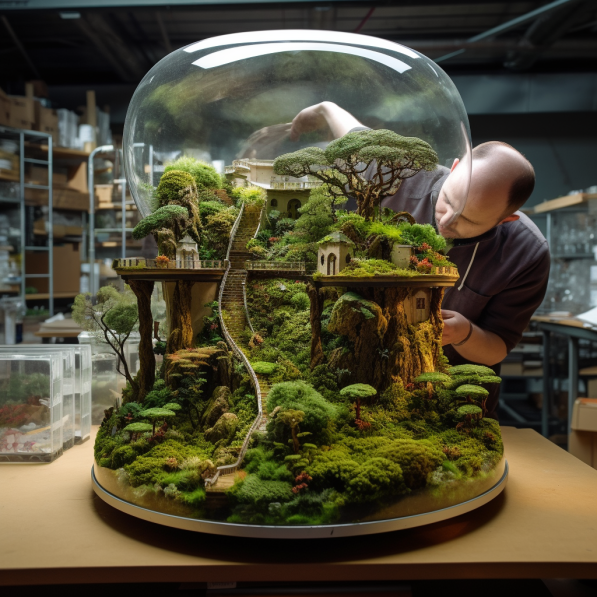For those who desire a slice of nature within their homes, a terrarium can be a perfect miniature ecosystem. These self-sustaining, low-maintenance, and aesthetic indoor gardens encapsulated in glass containers offer a fascinating way to grow a variety of plants. This comprehensive guide aims to provide you with the necessary steps and tips for creating your very own terrarium.
First Step – Understanding Terrariums
Terrariums are essentially glass containers housing a miniaturized, self-nourishing environment where plants can grow. The clear walls of the container allow for both heat and light to enter, creating an ideal environment for plant growth.
There are two main types of terrariums: closed and open. Closed terrariums have a removable lid or a small opening, and they retain a lot of moisture, making them perfect for humidity-loving plants. Open terrariums, on the other hand, are better suited for plants that prefer less humidity and more air circulation, such as succulents.
Choosing the Right Container
The choice of container for your terrarium is not just functional but also aesthetic. From simple glass jars to ornate lanterns and fish tanks, there are numerous options available. The only prerequisite is that the container must be clear glass to allow light to penetrate.
The size and shape of the container will depend on the type of terrarium you plan to create, the plants you wish to house, and the location you plan to display it. The container should be deep enough to accommodate layers of rocks, charcoal, and soil, and wide enough for you to arrange your plants.
Gathering Your Materials
Once you’ve chosen your container, it’s time to gather your materials. You’ll need rocks or pebbles for drainage, activated charcoal to keep the environment fresh, potting soil suitable for your chosen plants, and your plants.
You might also want to consider adding some decorative elements, like moss, decorative rocks, or miniature figurines, to give your terrarium a unique touch.
Assembling Your Terrarium
Assembling your terrarium is a step-by-step process:
a. Layering the Drainage Materials
Begin by adding a layer of rocks or pebbles to the bottom of your container. This layer ensures proper drainage, preventing water from pooling around the plant roots. The layer should be about 1-2 inches thick, depending on the size of your container.
Next, add a thin layer of activated charcoal. The charcoal helps to keep the terrarium environment fresh by filtering the air and preventing mold and bacteria growth.
b. Adding the Soil
On top of the charcoal, add a layer of potting soil. The amount of soil you add will depend on the plants you’re using, but usually, a layer of approximately 2-3 inches is sufficient. Make sure to use a potting mix suitable for your chosen plants. For example, succulents and cacti prefer a sandy, well-draining mix, while ferns and mosses prefer a richer, moisture-retaining mix.
c. Planting Your Plants
Now comes the fun part – planting your plants. Start by taking your plants out of their pots and gently teasing apart the roots. Dig a small hole in the soil and place your plant inside, firming the soil around the base.
Be mindful of the plant’s growth habits and needs when deciding their placement. Taller plants can go in the back, trailing plants near the edges, and shorter plants in the front. Leave
some space between the plants for air circulation and growth.
Caring for Your Terrarium
a. Watering
Watering requirements will depend on the type of terrarium. For closed terrariums, initially add a small amount of water. The closed environment will recycle moisture, so watering will rarely be necessary.
For open terrariums, water sparingly, ensuring the soil is moist but not waterlogged. Succulents and cacti in open terrariums require even less water.
Light and Temperature
Terrariums generally prefer bright, indirect light. Direct sunlight can heat the terrarium and burn the plants. If natural light is insufficient, artificial grow lights can be used.
Maintain a steady temperature in the room where the terrarium is kept. Avoid placing the terrarium near radiators, air conditioners, or drafty windows.
Troubleshooting Common Issues
Despite best efforts, sometimes issues may arise. Overwatering, insufficient light, or poor air circulation can lead to plant diseases or pests. Recognize the signs early and take appropriate action, such as adjusting watering schedules, moving the terrarium to a brighter spot, or introducing fresh air.
Creating a terrarium is a rewarding and creative way to bring a piece of nature into your home. It provides an opportunity to observe up close the wonder of a self-contained ecosystem. With proper care, your terrarium can thrive for years, providing endless joy and a serene green corner in your living space. Happy terrarium making!



